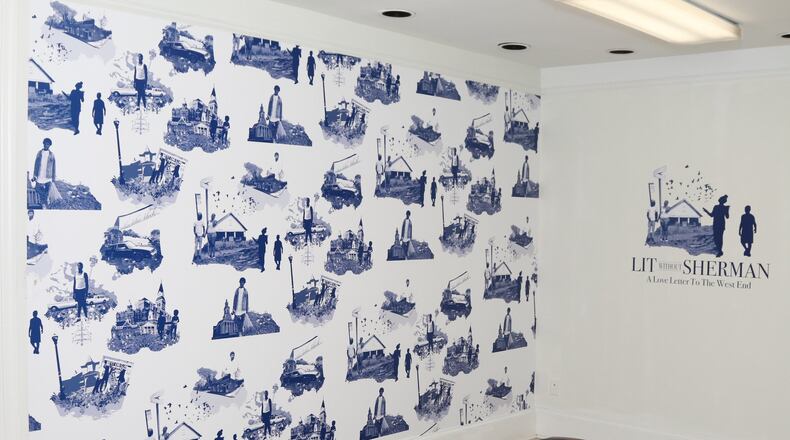Artist Shanequa Gay’s exhibition at Hammonds House Museum, “Lit Without Sherman: A Love Letter to the West End,” is a bittersweet Valentine that celebrates a vibrant slice of Atlanta rapidly changing with gentrification.
Working in collaboration with Hammonds House executive director Leatrice Ellzy Wright, who wanted Gay to create a site-specific installation in the historic Victorian home’s galleries, Gay has delivered an immersive, celebratory experience so loaded with emotion, your heart could burst. Gay has a gift for visual storytelling and shows sophistication when it comes to dramatic build, sinking viewers deeper into her story as it unfolds in successive rooms of Hammonds House.
MORE THINGS TO DO: National Center for Civil & Human Rights
The exhibition opens in the hallway of the home, whose walls have been painted sky blue and ornamented with lyrical, abstracted icons of West End life in white: street signs, church steeples and silhouettes of people that establish the contours but not the complexity of the world Gay is documenting. Turn a corner and that relatively subdued color scheme gives way to a riot of intense colors and a deeper immersion into place along with the introduction of Gay’s players: the denizens of the West End that the artist tags “The Welcoming Committee.” In that room, murals painted in electric shades of raspberry and orange directly on gallery walls feature West End residents in blue against that vibrant backdrop. The images spotlight the unique character and residents of the area, from the children selling water to passing motorists to the Muslim brothers selling pies, who Gay interviewed and photographed for “Lit Without Sherman.” Painted in similarly frenetic shades of green, red and black, another gallery pays tribute to the historically black colleges and universities (HBCU) schools—Morehouse, Spelman, Clark Atlanta, that occupy the West End and the students whose faces become a decorative motif woven into Gay’s vivid wallpaper.
A graduate of the Savannah College of Art and Design (SCAD) and Georgia State University, Gay conveys the flux, the excitement, the specificity of this place but also manages to distill a powerful vein of love and goodwill. What Gay has created is an essentially democratic, folksy portrait of a neighborhood made up of the ordinary people you’d pass on your way to work or school. Mimicking the toile wallpapers and fabrics which recreate scenes of pastoral life in the design world, in another gallery, Gay creates her own toile-style urban vignettes of souped-up cars and wooden bungalows, Andrew Young and black-owned businesses in an exceptionally witty collision of civic pride and design. Gay has presented a charming, celebratory tribute to black life.
In a video work that feels like the emotional centerpiece of the exhibition, a selection of Atlantans who have lived at various times in the West End; Morehouse and Spelman students, community activists and spoken word poet Adan Bean testify to the special magic of place, the collision of grit and authenticity, history and diversity that finds evangelists, drug dealers, church ladies and activists, intellectuals and college kids intersecting at the West End’s crossroads. In an especially moving section of the video, a Spelman student describes how she connected, after time in a preppy Northeastern boarding school, with her own identity as a black woman in the West End.
Striking the proper note of ascension in Hammond’s second floor, Gay has created a kind of “heaven” there for her tribute to “The West End Saints.” In imagery that references Renaissance paintings of saints, she has shrouded funeral director Willie A. Watkins, civil rights activist Jamil Abdullah Al-Amin, playwright Pearl Cleage and others in religious cloaks and golden haloes, marking them as fundamental forces in the creation of the spirit and identity of the West End.
Whether they’ve lived in the West End or some other unique sliver of the city, many Atlantans will find poignance and something profoundly relatable in the specific urban tapestry Gay describes: the feeling of a special, irretrievable quality being supplanted with something unknown, that will entail washing away some of the richness and complexity of place. Gay recognizes that place is a complex brew of forces, a delicate, evanescent balance that once it’s gone, is gone forever.
ART REVIEW
“Lit Without Sherman: A Love Letter to the West End”
Through October 15. 10 a.m.-6 p.m. Wednesdays-Fridays and Saturdays; 1 p.m.-5 p.m. Saturdays-Sundays. $7, adults; $5 seniors (62+); $5 students; free for children 12 and younger and museum members. Hammonds House Museum, 503 Peeples Street, SW, Atlanta. 404-612-0481, hammondshouse.org
Bottom line: An Atlanta artist delivers an affecting, poignant tribute to the people and places in Atlanta’s gentrifying West End.
About the Author
Keep Reading
The Latest
Featured





